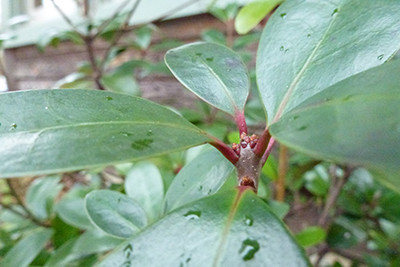
Plants of the Week: January 27
Ternstroemia gymnanthera ‘Sotall’
In the bleak conditions of mid-winter, evergreen plants can be essential to uphold a garden’s character. Ternstroemia gymnanthera is a small evergreen shrub that is native to southeastern Asia and is generally listed in hardiness zone 7a.
Blooming with small white flowers in the spring, its multi-seasonal interest continues into the winter with shiny evergreen foliage and subtle pops of red where the leaf petioles attach to the stem (similar to Daphniphyllum).
Ternstroemia is a member of the family Pentaphyllaceae and can reportedly reach heights of 15 feet at full maturity. It prefers well drained, acidic soil conditions similar Rhododendron. A small, healthy specimen can be found growing near the path between the Cunningham House and the Wister Center. photo credit: J. Bickel
Leucothoe fontanesiana
Commonly referred to as the drooping laurel or sometimes the highland doghobble, Leucothoe fontanesiana is a spreading, suckering, evergreen shrub with long arching branches and acuminate, serrated leaves. Native to the Appalachian Mountains of the eastern United States, Leucothoe is in the family Ericaceae with plants like Rhododendron and Vaccinium.
Like its relatives it prefers shaded, well drained, acidic soil habitats. In locations with a little more sun exposure, the leaves can turn a nice burgundy color. An often overlooked native understory shrub, it can provide an interesting green backdrop to shaded areas in the garden. L. fontanesiana can be found in many locations on campus; one particularly large planting can be seen by the sidewalk along College Avenue. photo credit: J. Bickel
Aucuba japonica ‘Cecil-Alice’
There are a multitude of variations and intensities of variegation patterns among the many cultivars of Aucuba japonica. ‘Cecil-Alice’ is especially interesting due to its densely spotted gold variegation pattern that resembles polished yellow-green granite. Truly evergreen, Aucuba japonica’s yellow and green foliar interest stands out against greens throughout the growing season and persists through the winter offering a lively tropical pop to a defoliated winter landscape.
A native to the rich forests of China, Japan and Korea, Aucuba fares well in shady locations. A small, happy specimen can be found growing in the Terry Shane Teaching Garden. photo credit: J. Bickel








No Comments